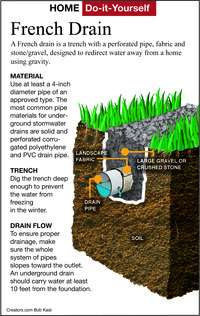Dear James: We have drainage problems and a damp basement in our house. When we select a lot for our new house, what potential drainage issues should we look for? — Gary C.
Dear Gary: Inadequate drainage can cause significant damage to your home in addition to creating a mess when your children are playing outdoors. One obvious problem is leaky basement walls and water damage from flooding, as you have experienced in your current house.
Less obvious problems are slow degradation of the lumber and other building materials from the constant dampness. Many hungry insects thrive in a damp environment, and some types can quickly munch away at the structural lumber, causing significant damage.
If you have some lots or existing houses in mind and you are not in rush to make your purchase, visit them after a rain storm. Although standing puddles are an obvious sign of problems, they're not the only one. Put on your boots and walk around the lot, paying particular attention to areas near the house that feel spongy and soggy.
Wait one day after the rain and visit the suspect areas again. If they seem to have dried out in a 24-hour period and now feel solid and stable, they will probably not cause serious problems. Have your real estate agent schedule your house tour at the time of your second visit to look for signs of indoor leaks. It often takes some time for the water to seep into the house after a rain.
When you look for lots to build a new house on, make the same inspections after a rain. Keep in mind that when a house is built on a lot, there is less ground area to absorb the water. If you notice any puddling, natural drainage paths or soggy soil, it will probably be worse after the house, driveway, patios, etc., are built.
If you are looking for a lot in a new subdivision, ask the builder to see the future plans. A lot may be very dry now, but if a clubhouse, recreational area or other streets will be located nearby and above your lot, it may create drainage problems. A lot with a 3-4 foot slope across it is ideal for natural drainage.
Also, pay attention to the location of nearby creeks. They may seem like just a trickle now, even after it rains. But once the subdivision is completed and much of the ground is covered with houses, concrete and asphalt, more water will run off into the creek instead of naturally being absorbed into the ground.
If you and your husband just fall in love with a particular lot that may have some potential drainage problems, there are a few things you can do. The foundation can be built a foot or two above the level of the ground. Slope the ground gradually away from the house to provide a natural path for the water.
Another option is to install a French drainage system, which is simple and usually effective. It is typically a trench (6 inches wide, 2 feet deep) dug around the house with perforated drainage pipe in the bottom. It's filled with 1 inch of gravel. Since water flows with less resistance through gravel than soil, it will drop into the trench, and the drainage pipe will carry it away.
Send your questions to Here's How, 6906 Royalgreen Dr., Cincinnati, Ohio, 45244 or visit www.dulley.com. To find out more about James Dulley and read features by other Creators Syndicate writers and cartoonists, visit the Creators Syndicate website at www.creators.com.






View Comments